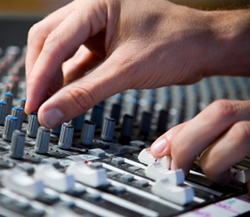On some of my gigs, it’s not uncommon to see a person walk up to the house console, reach in front of the mix engineer at that console, adjust a knob or fader, and then walk away.
For many in our business, mixing a live event is an individual operation, but my company has embraced a team approach to mixing.
I call it mixing by consensus, and we transitioned to it primarily due to our work with corporate events.
The most important thing on a corporate show is the client, followed in order by the event location, theme and décor, catering, bar, video, lighting, event photographer, and finally, audio. (At least that’s how if often seems!)
Clients and event planners don’t want to see a “big ugly” tech area in the middle of their event, so we rarely get a good front-of-house location. On many gigs, it’s at the very back corner of a large room, well away from the main PA hangs.
Sometimes the client doesn’t want to see the console at all, or there isn’t enough room for a mix position anywhere in the room, so we mix from the side of the stage, or even worse, from backstage. Even when we have a decent front-of-house position, there’s usually a myriad of fill and delay loudspeakers to also keep an eye (well, ear) on.
All of this generally means that the mix engineer needs to leave the console to hear what’s really going on in the room, then return to make adjustments, and then walk away again, and on and on. Of course we set up small loudspeakers regardless of location to mix from, and we also use headphones, but this just doesn’t tell us what’s really going on with sound in the room.
Corporate clients also have a habit of going off script and unexpectedly asking for video playback, audio cues, Q&A microphones turned on, etc. Having to dash back to a console to un-mute a channel more times than I care to remember made me confront the fact that a second audio mix person was needed on many gigs.
The use of radios, where the second person in the house might relay input to the mix engineer, is pretty much a non-starter at these types of gigs due to general aesthetic and noise/disruption issues. (During a corporate speech or other often-subtle programming, i.e., a classical music production, someone talking into a radio would be a major distraction.)
So we always have one person at the console, ready to un-mute a feed, adjust a mic level, or play an audio “sting,” while the other person regularly walks the room listening. The walker is given the freedom to come to the house console and adjust a knob or fader based upon what they heard.
The two people can also switch places, alternating between walking the room and manning the console. For larger events, we’ve even expanded this concept, with three or more people participating.
We do have one person overall responsible for the audio, but the bottom line is that we don’t let egos get in the way of getting a good mix for the client.
The key to making this work is good communication before the gig. Each person assisting with the mix is well versed pn how the client wants the audio presented, and further, anybody involved with manning the console knows the script and the cues.
The old saying “too many cooks may spoil the broth” might be true, but we’ve found, at least in these situations, that more than one engineer can sweeten the mix!
My goal is to provide the best audio for my clients, and if it takes more than one mix engineer, so be it.
Craig Leerman is senior consulting editor for Live Sound International, and has worked in professional audio for more than 25 years. He is also the owner of Tech Works, a regional production company based in Las Vegas that focuses on live corporate events.















